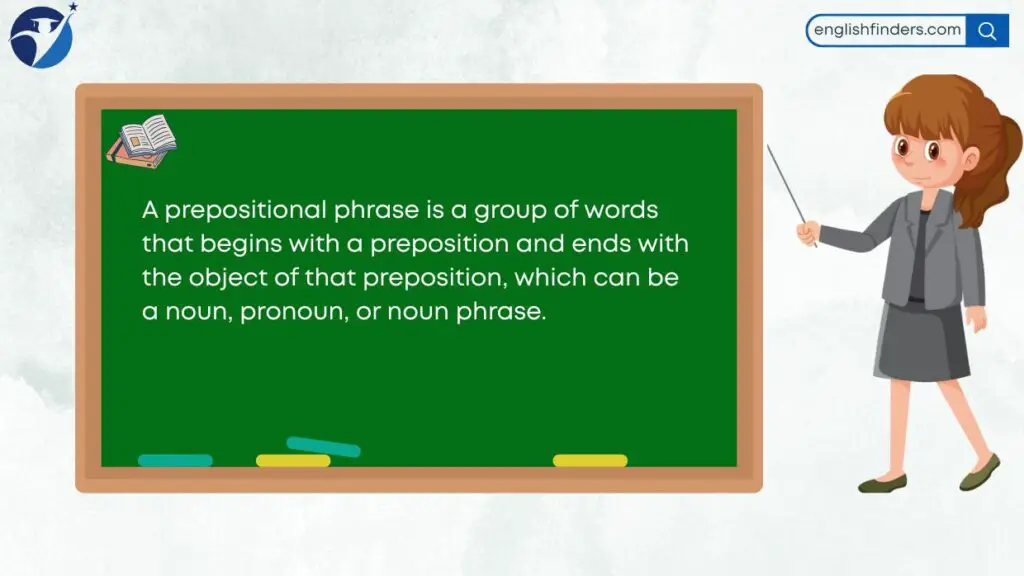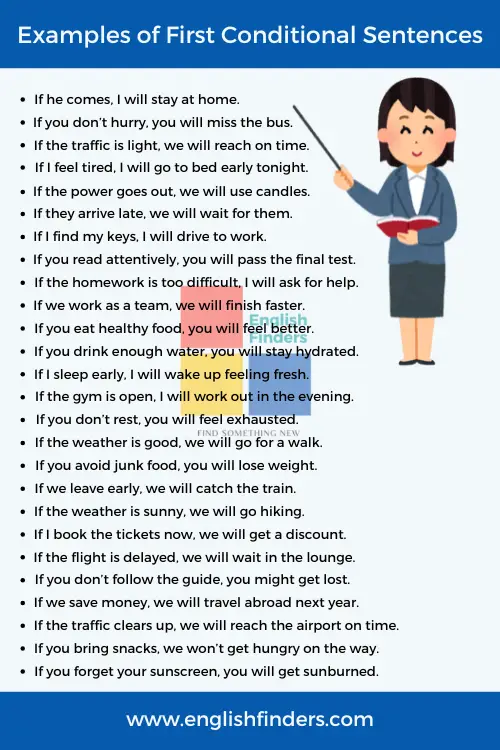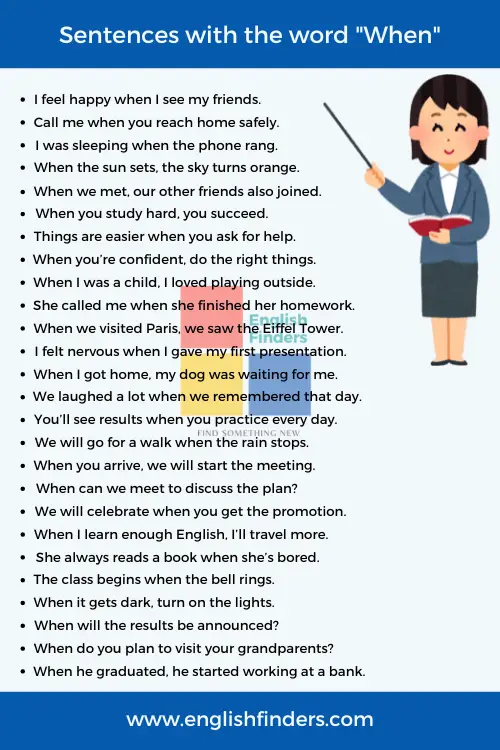Last updated on May 26th, 2025 at 03:19 pm
Prepositional phrases might sound complicated, but they’re actually very common in our everyday English. You probably use them all the time without even realizing it! A prepositional phrase is simply a group of words that starts with a preposition (like in, on, or at) and ends with a noun or pronoun. These phrases help us add important details to our sentences, like where something is happening, when it’s happening, or why it’s happening.
Understanding prepositional phrases is key to improving your English grammar skills. They help make your sentences more interesting and clearer. In this lesson, we’ll walk through 50 examples of prepositional phrases and explain how they work so you can start using them more effectively in your own English conversations and writing.
What is a Prepositional Phrase?
Quick Navigation

A prepositional phrase is a group of words that begins with a preposition and ends with the object of that preposition, which can be a noun, pronoun, or noun phrase. Prepositions are words that show relationships between other words in a sentence, such as in, on, at, by, and under. These phrases help us understand where, when, how, or why something happens.
For example, in the sentence, “The cat is under the table,” the prepositional phrase is under the table. Here, under is the preposition, and the table is the object of the preposition, giving us more detail about where the cat is.
Prepositional phrases can do two main things: describe nouns or pronouns (adjective phrases) or describe verbs (adverbial phrases). For instance, in the sentence “The book on the shelf is mine,” the phrase on the shelf describes the noun book. In the sentence “She ran across the street,” the phrase across the street tells us more about where she ran, modifying the verb ran.
Structure of a Prepositional Phrase
A prepositional phrase has a simple structure: it starts with a preposition and ends with the object of the preposition. The object can be a noun, a pronoun, or even a noun phrase. Here’s a quick breakdown:
- Preposition: This is the word that shows the relationship between the object and the rest of the sentence. Common prepositions include in, on, at, by, with, for, and under.
- Object of the Preposition: This is the noun, pronoun, or noun phrase that follows the preposition. It tells us what or whom the preposition is referring to.
Let’s look at an example:
- “She is sitting on the chair.”
In this sentence, “on” is the preposition, and “the chair” is the object of the preposition. Together, they form the prepositional phrase on the chair, which tells us where she is sitting.
Another example:
- “We are going to the new street.”
Here, “to” is the preposition, and “the new street” is the object, forming the prepositional phrase to the new street, which tells us where we are going.
It’s important to choose the correct preposition based on the context. For instance, in and on might both indicate location, but they have different meanings. You’d say “in the room” for something inside the room and “on the table” for something resting on the surface.
Types of Prepositional Phrases

Prepositional phrases can serve different purposes in a sentence, depending on how they are used. They typically fall into two main categories: adjective phrases and adverbial phrases. Let’s break down what each type does and how they add meaning to your sentences.
1. Adjective Phrases
An adjective phrase is a prepositional phrase that describes or modifies a noun or pronoun. It works like an adjective by giving more information about the noun in the sentence. These phrases answer questions like Which one? or What kind?
Example:
- “The laptop in the drawer is mine.”
In this sentence, “in the drawer” is the prepositional phrase that tells us more about the noun laptop. It helps us understand which laptop we’re talking about.
Another example:
- “The dog with the brown spots is friendly.”
Here, “with the brown spots” is an adjective phrase that tells us more about the dog, helping to identify which dog is being described.
2. Adverbial Phrases
An adverbial phrase is a prepositional phrase that modifies a verb, adjective, or another adverb. These phrases provide details about how, when, where, or why something happens, just like adverbs do.
Example:
- “She arrived after the meeting.”
In this sentence, “after the meeting” is a prepositional phrase that modifies the verb arrived, telling us when she arrived.
Another example:
- “They have played cricket in the Melbourne Cricket Ground.”
Here, “in the Melbourne Cricket Ground. is an adverbial phrase that tells us where they played, giving more context to the action of playing.
Recognizing the Difference
- If the prepositional phrase describes a noun, it’s an adjective phrase.
- If it’s giving more information about a verb, adjective, or adverb, it’s an adverbial phrase.
50 Examples of Prepositional Phrases in Sentences
Here are 50 examples of prepositional phrases, each used in a sentence. To make it more useful, I’ve included various verb tenses to show how these phrases fit into different sentence structures.
Prepositional Phrases Showing Location
- She was reading in the library.
- The book on the shelf is a bestseller.
- We met at the cafe last night.
- The cat is hiding under the bed.
- The paintings in the museum are priceless.
- They were standing in front of the house.
- We have been walking along the beach for hours.
- The students in the classroom are studying.
- I found my notebook between the cushions.
- The flowers in the garden bloom every spring.
Prepositional Phrases Showing Time
- I will finish the project by tomorrow.
- She studied during the night for the exam.
- They had already left before sunrise.
- The meeting before lunch was very productive.
- The classes held in the morning are usually less crowded.
- The picnic planned for this weekend is weather-dependent.
- She had completed her homework before the deadline.
- The movie released on Friday was highly anticipated.
- He visited his grandparents on the weekend.
- The festival in the spring celebrates local culture.
Prepositional Phrases Showing Direction
- The road to the city is under construction.
- She is heading to the grocery store now.
- The path toward the mountains is steep and rocky.
- The dog ran into the garden chasing the squirrel.
- He was driving through the tunnel when it started raining.
- She moved away from the door when it opened.
- The car in front of the building is parked illegally.
- The kids were jumping over the fence to get the ball.
- He had walked past the school before realizing he was lost.
- The bird flew out of the cage when we weren’t looking.
Prepositional Phrases Showing Cause/Reason
- She is staying home because of the severe flu.
- They canceled the event due to bad weather.
- He didn’t go to the party for this personal reason.
- We had to leave early on account of the traffic.
- They missed the flight because of the delay.
- I am grateful for all your help.
- She couldn’t finish the exam due to lack of time.
- He succeeded because of his hard work.
- The concert was postponed on account of the rain.
- The improvement due to consistent practice was noticeable.
Prepositional Phrases Showing Condition
- She was calm in spite of the chaos around her.
- He worked hard despite his illness.
- We were happy with the results of the test.
- The house under renovation looks completely different now.
- The book with missing pages is difficult to read.
- The game was canceled except for the finals.
- I am confident in my abilities to succeed.
- Sezan completed his task according to the instructions.
- We solved the problem with the help of a mentor.
- The student under stress doesn’t perform well in the exam.
Final Thoughts
Prepositional phrases are essential tools in English grammar that help us add important details to our sentences, making them more precise and engaging. When talking about time, location, direction, or even reasons behind an action, prepositional phrases allow you to express yourself clearly and accurately. I hope these 50 examples of prepositional phrases help you to make more engaging sentences using various prepositional phrases.
Frequently Asked Questions
What is a prepositional phrase?
A prepositional phrase is a group of words that consists of a preposition and ends with the object of the preposition, which can be a noun, pronoun, or noun phrase. For example, in the phrase in the garden, “in” is the preposition, and the garden is the object.
What is the difference between an adjective phrase and an adverbial phrase?
An adjective phrase modifies a noun or pronoun, providing more detail about it. For example, in the sentence “the book on the table“, “on the table” describes the book. An adverbial phrase modifies a verb, adjective, or another adverb, giving more context to the action. For instance, in She runs quickly in the Street, “in the Street tells” us where she runs, while quickly modifying how she runs.
Can a prepositional phrase be more than two words?
Yes, a prepositional phrase can consist of multiple words. While it always begins with a preposition and ends with an object, the object can include modifiers. For example, in the phrase in the bright, sunny morning, “in” is the preposition, and “the bright,” “sunny morning” is the object, which includes adjectives describing the morning.

Azizul Hakim is the founder & CEO of englishfinders.com. He is a passionate writer, English instructor, and content creator. He has completed his graduation and post-graduation in English language and literature.




